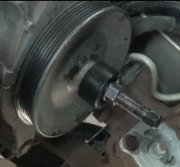Hi wolfwolf1. Welcome to the forum. As a very experienced brake and alignment specialist, I can tell you that anyone can run into this problem. To start with, I'll just list a bunch of possibilities while going on the assumption the problem started after the service work was done. It could have been there before but was not as noticeable, but chances are it wasn't.
The brake rotors could be warped but they'd have to be pretty bad to only notice it when you're NOT braking. It's common for new rotors to warp within a few months. Machining them usually solves the problem. This is more common with the less-expensive Chinese rotors but there's nothing wrong with the quality. In the U.S, parts made from cast iron are left out to "age" for 90 days before the final machining. In China, the parts are cast, then immediately shipped They age on the car and sometimes warp. Once machined, they will be fine.
There are bolt access holes in the hub that the rotor mounts on. Water splashes up there and makes rust spots on the backside of the rotors. If that rust isn't cleaned off, they will not mount squarely on the lathe and a warp will be machined into them. That only apples if the old rotors were reused.
Regardless if the rotors were replaced or reused, debris can fall behind the rotor and prevent it from sitting squarely on the hub. That will cause the wheel to wobble too. To find these problems, a dial indicator is placed against the lip of the wheel, then it is run in gear with the front end jacked up. Typically anything over about.040" of sideways runout should be investigated.
The same test is performed next on the brake rotor. If the runout is still there, the rotor is warped, the hub is bent, or there is debris between them. If there is no excessive runout on the front wheels, look next for a broken belt in one of the tires. This is more common on high-mileage tires, not on new ones. While the tires are spinning, watch the tread from in front of the vehicle to see if there is any sideways movement. If there is, but not in the wheel, suspect a broken belt. If you aren't sure if a belt is the problem, switch the two wheels and tires on one side, front to back and drive the van to see if the problem changed. If it didn't, switch the two on the other side and try it again. If the vibration stays exactly the same, the problem has to be related to the hubs or brake rotors.
Finally, tire balancers can be out of calibration. One clue is if you see three equally-spaced weights on one side of one wheel, inside, outside, or both sides, or if you see one large weight and a smaller weight across from it. A recent improvement in balancing is a "road force balancer". This is a machine that puts around 800 pounds of force on the tire as it slowly spins. This identifies soft spots in the sidewall that are a common result of uneven curing of the rubber. This makes the spindle actually drop a little once per tire revolution. Years ago we didn't notice this, but vehicles today ride so smoothly that we can feel the slightest irregularities. You may need to visit a tire specialty shop to have the two front tires rebalanced. Think of it as a second opinion. They will have the best balancing equipment.
Caradiodoc
Tuesday, May 4th, 2010 AT 12:59 AM



